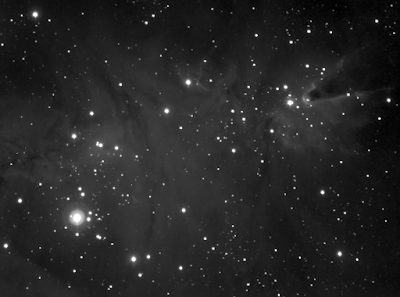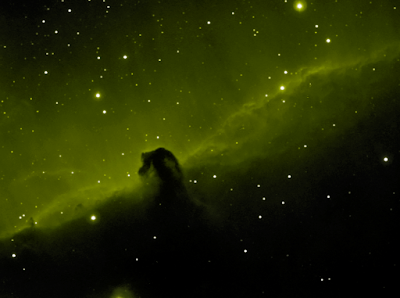Today I saw the Horsehead Nebula as I've never seen it, courtesy of an image from the ESO/J. Emerson/VISTA. Here's a link to January 12, 2010's APOD:
Horsehead (and Flame). The focus of this image is the Flame Nebula and the cluster of stars in its center, but the Horsehead is stunning. It is basically the reverse of what we normally see. In visible light, the Horsehead is dark and the background lit up around it, as
here (and also below). In the APOD image, the head is lit up, and the background is dark except for the stars. The glowing hydrogen that usually frames the dust making up the horse head is invisible in infrared. With the infrared dust glowing against the background, one sees the head for what it is, not its silhouette!
The images below illustrate the point. I've been trying to catch a new image of the Horsehead, and I'm not entirely satisfied with what I have as of yet, but I can use the H-alpha image that I have taken and combine it with the ESO's Horsehead (used here with permission). This allows both visible and H-alpha in one image. The infrared colors are all imaginary, of course, because the infrared lies outside the visible spectrum. H-alpha, on the other hand, lies in the red part of the visible spectrum and is colored red in this image:

In black and white, the image would look like this:

Without the infrared, the Ha shows a much less interesting Horsehead:

Thanks and congratulations to the ESO and collaborators for providing a beautiful image of what would otherwise be an invisible cloud of dust!
.png)
C.png) This is a fresh attempt at the Cone Nebula. My first attempt was rather pathetic (here), and this is a big improvement.
This is a fresh attempt at the Cone Nebula. My first attempt was rather pathetic (here), and this is a big improvement..png)
C.png)
2.png)



HubPal3.png)
HaOIIISII-Fine.png)